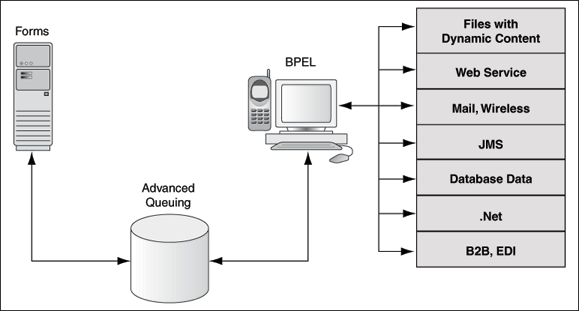Oracle Forms and Server Events
With the exception of timers, most events in Oracle Forms occur from some kind of user interaction.
In versions prior to 11g of Oracle Forms, there was no easy support to receive an external event if it could not be bound to the Form's graphical user interface. Forms clients had to use techniques such as polling through a great deal of coding to respond to these events to deal with external events that it did not initiate.
Beginning with Oracle Forms 11g and Oracle Database, you can handle external events, such as asynchronous events, by using the database queue. Oracle Streams Advanced Queuing (AQ), an asynchronous queuing feature, enables messages to be exchanged between different programs. AQ functionality is implemented by using interfaces such as DBMS_AQ, DBMS_AQADM, and DBMS_AQELM, which are PL/SQL packages. For information about Advanced Queuing, see Transactional Event Queues and Advanced Queuing User's Guide.
In general, the steps required to integrate events and database queues are:
Database
- Create a queue table: Define the administration and access privileges (AQ_ADMINISTRATOR_ROLE, AQ_USER_ROLE) for a user to set up advanced queuing. Define the object type for the payload and the payload of a message that uses the object type. Using the payload, define the queue table.
- Create a queue: Define the queue for the queue table. A queue table can hold multiple queues with the same payload type.
- Start the queue: Enable enqueue/dequeue on the queue.
- Enqueue a message: Write messages to the queue using the DBMS_AQ.ENQUEUE procedure.
Note:
Forms integration with Advanced Queuing is not supported with Autonomous Database.Form Builder
- Create an event object: Create a new event in the Events node in the Object Navigator in the Form Builder.
- Subscribe the event object to the queue: The name of the queue is specified in the Subscription Name property.
- Code necessary notification: Write the event handling function, which is queued up for execution by Forms and is executed when the server receives a request from the client. Write the trigger code for the When-Event-Raised trigger that is attached to the Event node.
Forms Services
- Run the form and register the subscription
- Invoke the When-Event-Raised trigger upon event notification
In earlier versions of Forms, handling external events was only possible through custom programming, usually done in Java with the help of Forms' Java Bean support. Beginning in Oracle Forms 11g, it is possible to call into Forms from any technology that can interface with Advanced Queuing (AQ), for example Java Messaging (JMS).
As shown in the following image the flow of events that take advantage of the improved integration of the different components your application might work with. In the left side of the image, the Oracle Forms has two-way communication with the AQ functionality of Oracle Database. In the center of the image, the AQ function of Oracle Database also has two-way communication with the possible outside events that can trigger internal Forms events. In the right side of the image, these external events can include technologies such as files with dynamic content, Web services, mail, JMS, or database content that interact with BPEL processes which in turn interact with AQ. BPEL, however, is not necessary. JMS, as an example, can interact with AQ directly without having to go through BPEL.
Note:
Third party tools such as antivirus and security software may prevent Advanced Queuing from working correctly with Oracle Forms. As a workaround, turn off any third party security tools.Figure -24 Oracle Forms Handles Outside Events with Advanced Queuing in Oracle Database

Description of "Figure -24 Oracle Forms Handles Outside Events with Advanced Queuing in Oracle Database"